AUDI Q3 2016 Workshop Manual
Manufacturer: AUDI, Model Year: 2016, Model line: Q3, Model: AUDI Q3 2016Pages: 252, PDF Size: 62.81 MB
Page 51 of 252
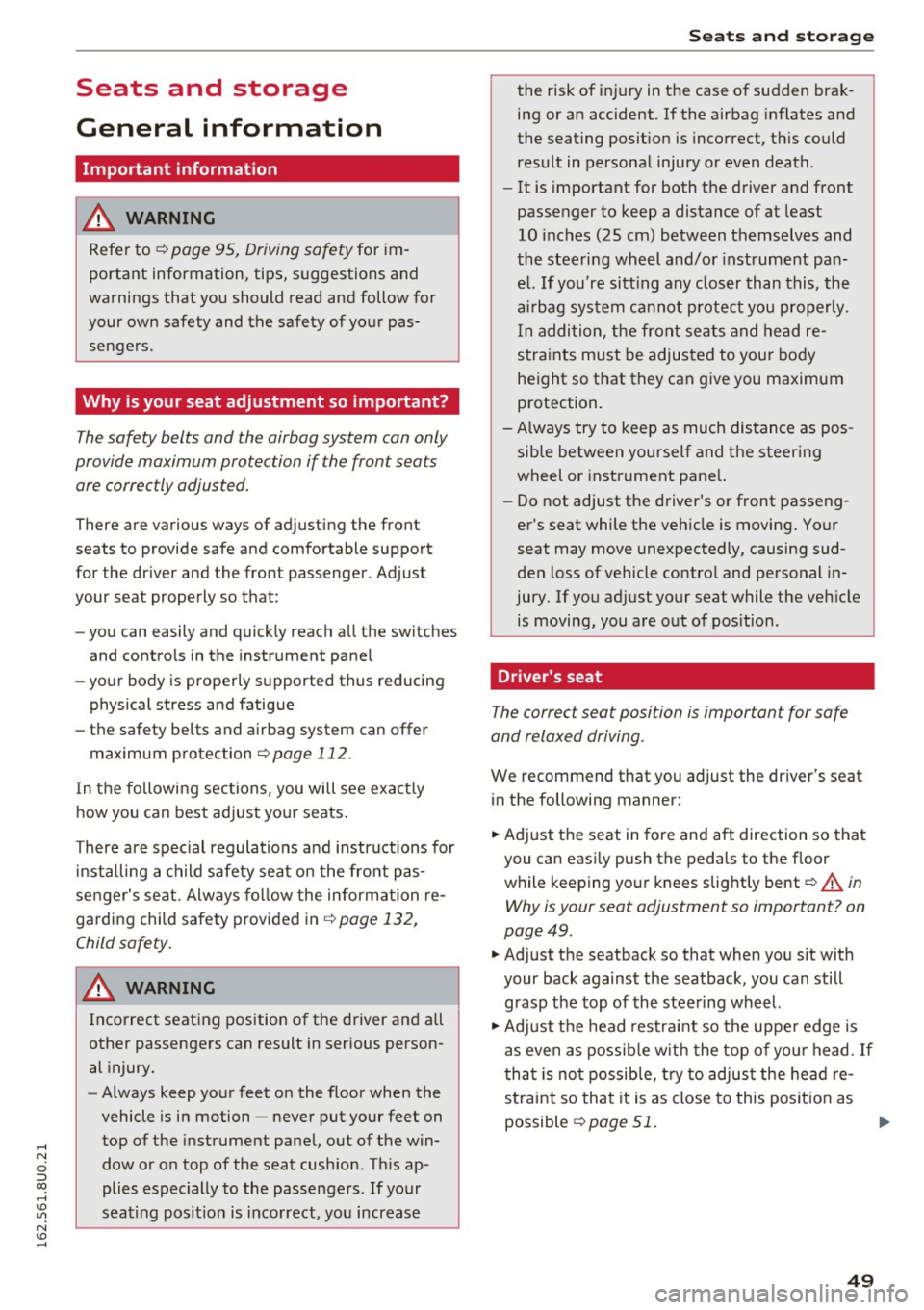
Seats and storage
General information
Important information
A WARNING
-
Refer to ¢ page 95, Driving safety for i m
portant information, tips, suggestions and
warnings that you should read and follow for
your own safety and the safety of your pas
sengers.
Why is your seat adjustment so important?
The safety belts and the airbag system can only
provide maximum protection if the front seats
are correctly adjusted.
There are various ways of adjusting the front
seats to provide safe and comfortable support
for the driver and the front passenger. Adjust
your seat properly so that:
- you can easily and quick ly reach all the switches
and controls in the instrument pane l
- your body is properly supported thus reducing
physical stress and fatigue
- the safety belts and airbag system can offer
maximum protection
¢ page 112.
In the following sections, you will see exact ly
how you can best adjust your seats.
There are special regulations and instructions for in stalling a ch ild safety seat on the front pas
senger's seat . Always follow the information re
garding child safety provided in
¢ page 132,
Child safety .
A WARNING
Incorrect seating position of the driver and all
other passengers can result in serious person
al injury.
- Always keep yo ur feet on the floor when the
vehicle is in motion -never put your feet on
top of the instrument pane l, out of the win
dow or on top of the seat cushion. Th is ap
plies especially to the passengers. If your
seating pos it ion is inco rrect, you increase
Seat s and sto rage
the risk of injury in the case of sudden brak
ing or an accident. If the airbag inflates and
the seating posit ion is incorrect, th is could
result in persona l injury or even death.
- It is important for both the driver and front
passenger to keep a distance of at least
10 inches (25 cm) between themselves and
the steering wheel and/or instrument pan
el. If you're sitt ing any closer than this, the
ai rbag system cannot protect you properly.
I n addition, the front seats and head re
stra ints must be adjusted to you r body
height so that they can give you maximum
protection.
- Always try to keep as much dis tance as pos
sible between yourself and the steering
wheel or instrument pane l.
- Do not adjust the driver's o r front passeng
er's seat while the vehicle is moving . Your
seat may move unexpectedly, causing sud
den loss of vehicle contro l and personal in
jury. If you ad just your seat while the veh icle
is moving, you are o ut of pos ition.
Driver's seat
The correct seat position is important for safe
and relaxed driving.
We recommend that you adjust the driver's seat
in the following manner:
.. Adjust the seat in fore and aft direction so that
you can easi ly push the pedals to the f loor
while keeping yo ur knees slight ly bent ¢
A in
Why is your seat adjustment so important? on
page 49.
.. Adjust the seatback so that when you sit with
your back against the seatback, you can still
grasp the top of the stee ring wheel.
.. Adj ust the head restra int so the uppe r edge is
as
even as possib le w it h the top of yo ur head. If
tha t is no t possible, t ry to adjus t the hea d re
st raint so tha t it is as close to this pos it ion as
possible
¢ page 51. .,.
49
Page 52 of 252
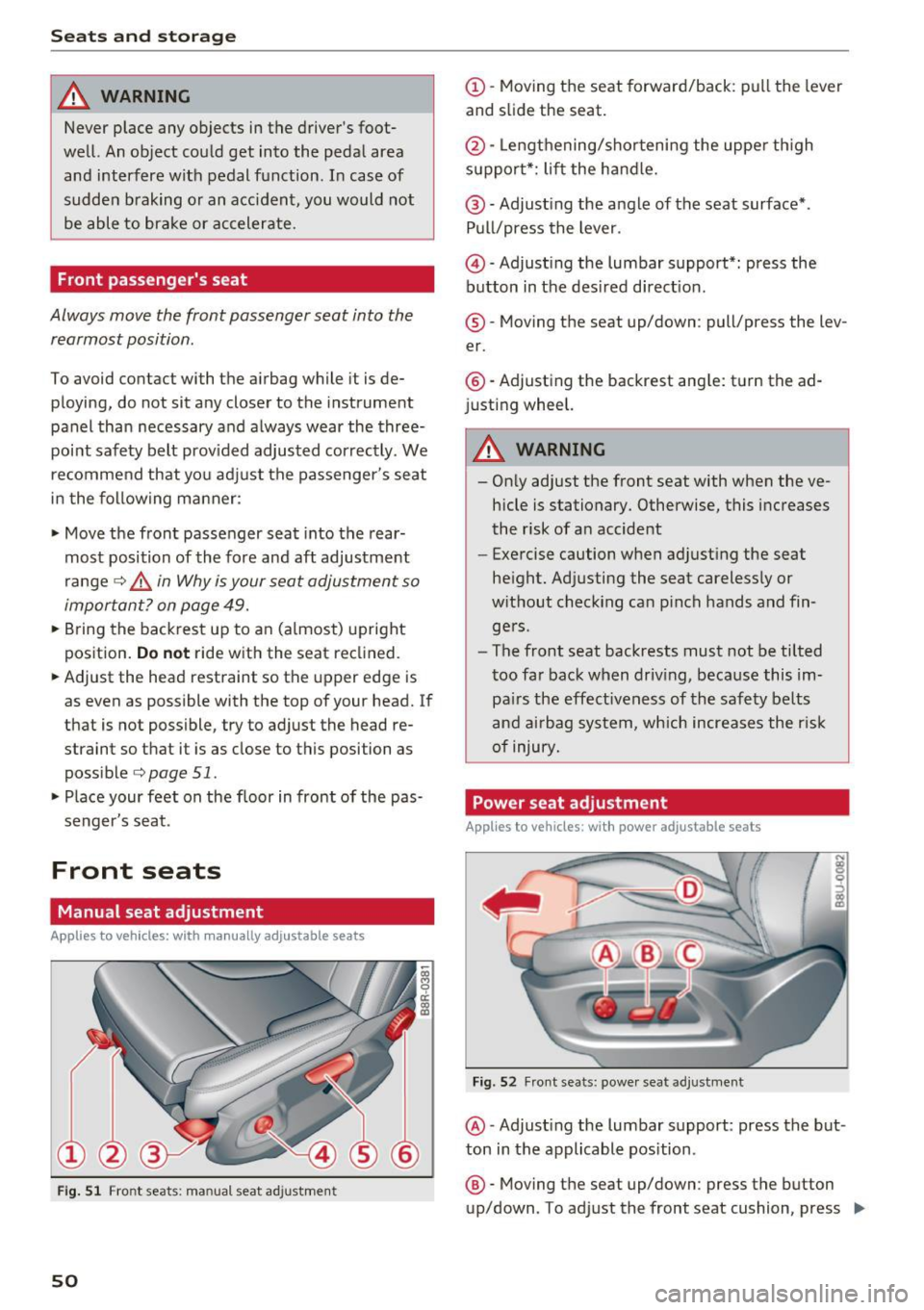
Seats and storage
_& WARNING
Never place any objects in the driver's foot
well. An object could get into the pedal area and interfere with pedal function. In case of
sudden braking or an accident, you would not
be able to brake or accelerate.
Front passenger's seat
Always move the front passenger seat into the
rearmost position.
To avoid contact with the airbag while it is de
ploying, do not sit any closer to the instrument
panel than necessary and always wear the three
point safety belt provided adjusted correctly. We
recommend that you adjust the passenger's seat
i n th e following manner:
• Move the front passenger seat into the rear
most position of the fore and aft adjustment
range ¢,&.
in Why is your seat adjustment so
important? on page 49.
• Bring the backrest up to an (almost) upright
position. Do not ride with the seat reclined.
• Adjust the head restraint so the upper edge is
as even as possible with the top of your head. If
that is not possible, try to adjust the head re
straint so that it is as close to this position as
possible¢
page 51.
• Place your feet on the floor in front of the pas
senger's seat.
Front seats
Manual seat adjustment
Applies to vehicles: with manually adjustable seats
Fig. 51 Front seats: manua l seat adjustme nt
50
(D -Moving the seat forward/back: pull the lever
and slide the seat.
@-Lengthen ing/shortening the upper thigh
support*: lift the handle.
@ -Adjusting the angle of the seat surface*.
Pull/press the lever.
@) -Adjusting the lumbar support*: press the
button in the desired direction.
® -Moving the seat up/down: pull/press the lev
er.
@ -Adjusting the backrest angle: turn the ad
ju sting wheel.
_& WARNING
-Only adjust the front seat with when the ve
hicle is stationary. Otherwise, this increases
the risk of an accident
- Exercise caution when adjusting the seat
height. Adjusting the seat carelessly or
without checking can pinch hands and fin gers.
- The front seat backrests must not be tilted
too far back when driving, because this im
pairs the effectiveness of the safety belts
and airbag system, which increases the risk
of injury.
Power seat adjustment
Applies to vehicles: with power adjustable seats
Fig . 52 Front seats: power seat adjustme nt
@ -Adjusting the lumbar support: press the but
ton in the applicable position.
@ -Moving the seat up/down: press the button
up/down. To adjust the front seat cushion, press
IJJI,
Page 53 of 252
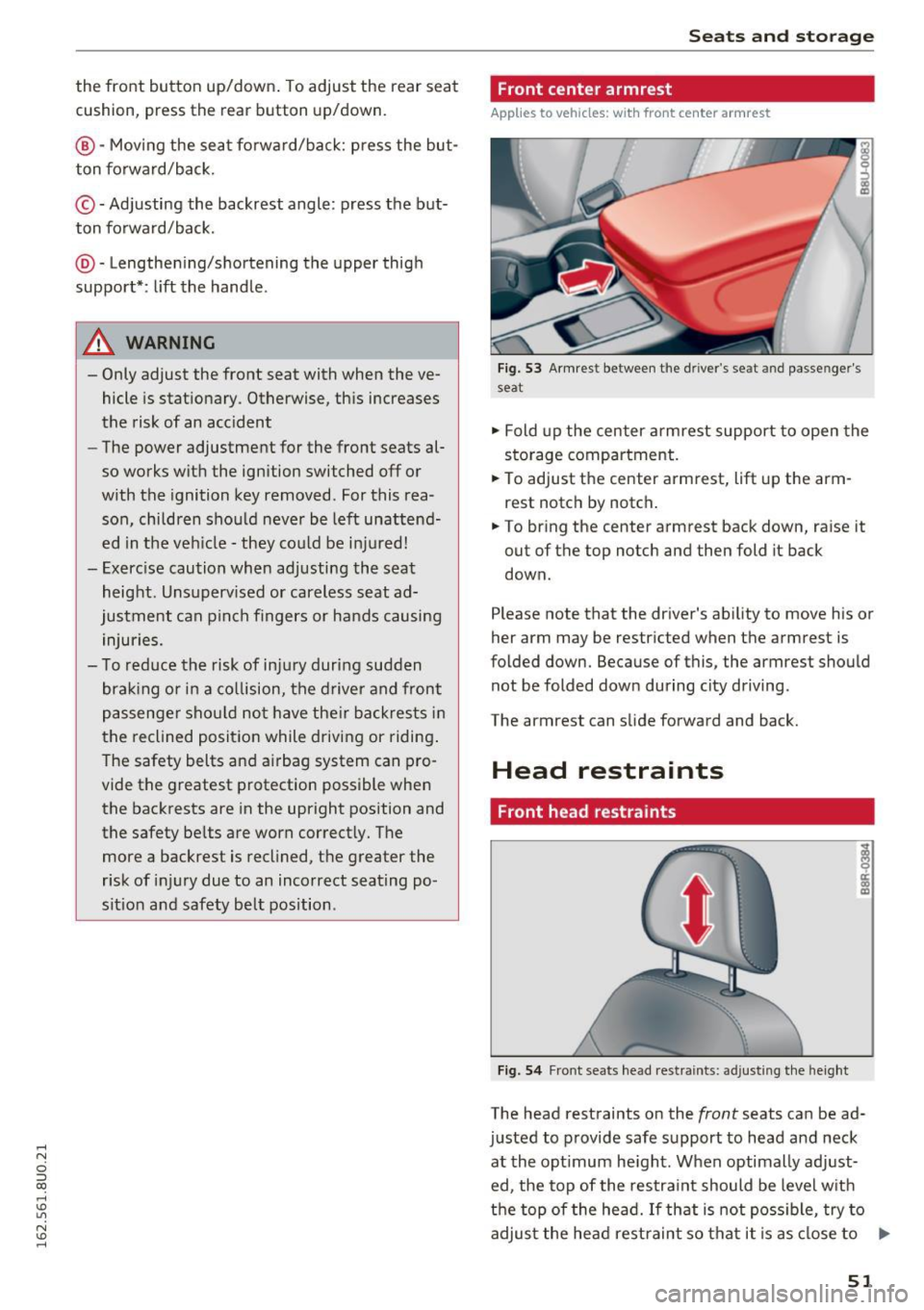
.... N
c:i :::J CX)
.... I.Cl U"I
N I.Cl ......
the front button up/down. To adjust the rear seat
cushion, press the rear button up/down.
@-Moving the seat forward/back: press the but
ton forward/back.
© -Adjusting the backrest angle: press the but
ton forward/back.
@ -Lengthen ing/shortening the upper thigh
support* : lift the handle .
.&_ WARNING
- Only adjust the front seat with when the ve
hicle is stationary. Otherwise, this increases
the risk of an acc ident
- The power adjustment for the front seats al
so works with the ignition switched off or
with the ignition key removed . For this rea
son, children should never be left unattend
ed in the veh icle -they could be injured!
- Exerc ise caution when adjusting the seat
height. Unsupervised or careless seat ad
justment can p inch fingers or hands causing
injuries.
- To reduce the risk of injury during sudden
braking or in a collision, the driver and front
passenger should not have their backrests in
the reclined position while driving or riding .
The safety belts and airbag system can pro
vide the greatest protection possible when
the backrests are in the upright position and
the safety belts are worn correctly. The
more a backrest is reclined, the greater the
risk of injury due to an incorrect seating po
sition and safety belt position .
Seats and storage
Front center armrest
Applies to vehicles: with front center armrest
Fig. 53 Armrest betwee n the dr iver 's seat and passenger's
seat
.,. Fold up the center armrest support to open the
storage compartment .
.,. To adjust the center armrest, lift up the arm
rest notch by notch.
.,. To bring the center armrest back down, raise it
out of the top notch and then fold it back
down.
Please note that the driver's ability to move his or
her arm may be restricted when the armrest is
folded down. Because of this, the armrest should
not be folded down during city driving.
The armrest can slide forward and back.
Head restraints
Front head restraints
Fig. 54 Front seats head res traints: adjusting the height
The head restraints on the front seats can be ad
justed to provide safe support to head and neck at the opt imum height . When optimally adjust-
ed, the top of the restraint should be level with
the top of the head. If that is not poss ible, try to
adjust the head restraint so that it is as close to ..,.
51
Page 54 of 252
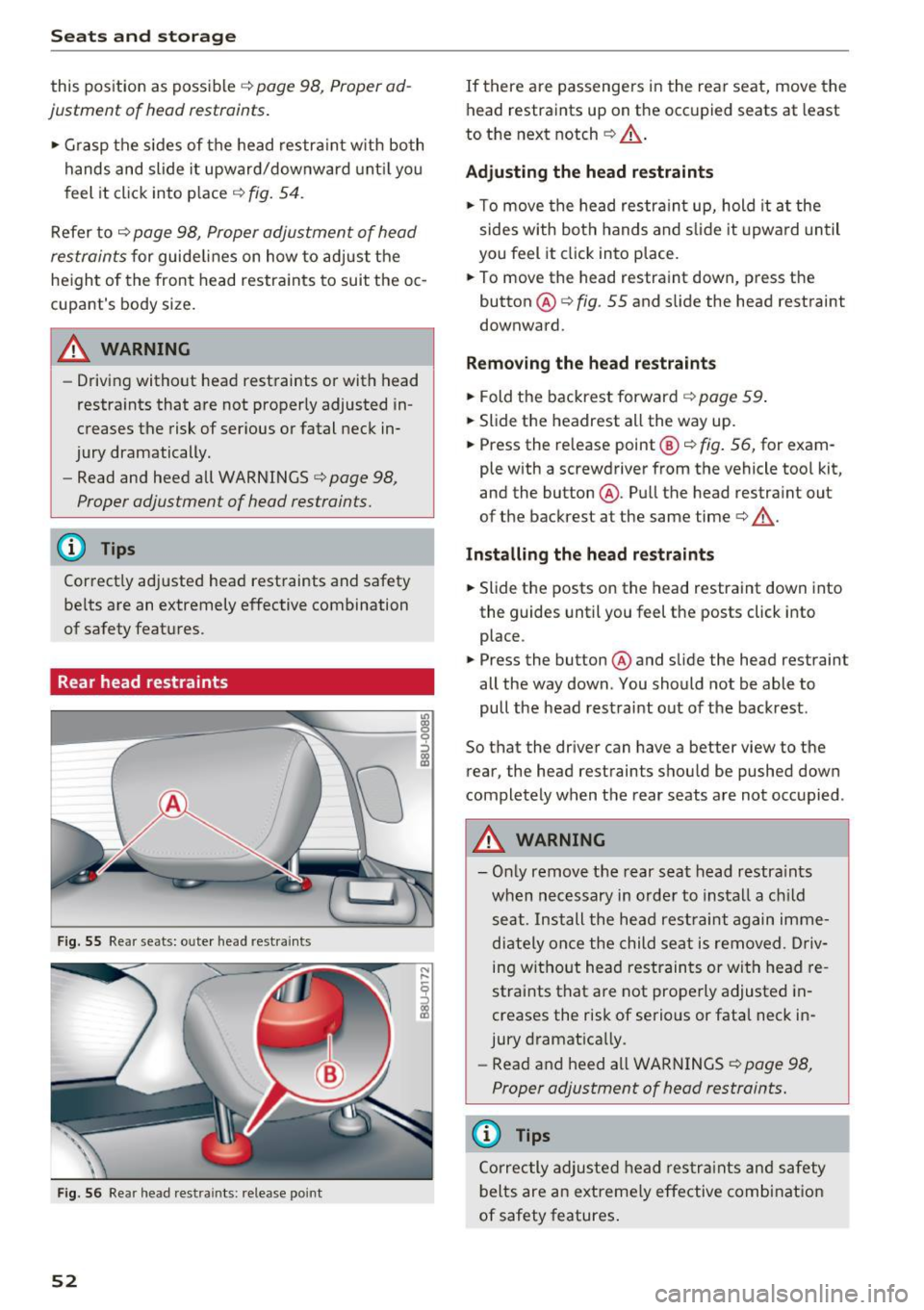
Sea ts and stor age
this position as possible ¢ page 98, Proper ad
justment of head restraints .
.. Grasp the sides of the head restra in t w ith both
hands and slide it upward/downward unt il you
f eel it click into p lace
¢ fig. 54.
Refer to ¢ page 98, Proper adjustment of head
restraints
f or guide lines on how to adjust the
height of the front head restraints to suit the oc
cupant's body size.
_& WARNING
- Driving without head restraints or with head
restra ints that are not properly adjusted in
creases the risk of serious or fatal neck in
jury dramatically.
- Read and heed all WARNINGS¢
page 98,
Proper adjustment of head restraints.
@ Tips
Cor rect ly adjusted head restraints and safety
be lts are an extremely effective combination
of safety features .
Rear head restraints
F ig . 5 5 Rear seats: oute r head rest ra in ts
Fig . 56 Rear head restra ints: release po int
52
If there are passengers in the rear seat, move the
head restraints up on the occ upied seats at least
to the next notch
¢ A .
Adjusting the head restraints
.. To move the head restra int up, hold it a t the
sides with both hands and s lide it upward until
you feel it click into place.
.. To move the head restraint down, press the
button @¢
fig. 55 and s lide the head restraint
downward .
Remo ving the head r estraint s
.. Fold the backrest forwar d
<=.> page 59.
.. Slide the headrest all the way up.
.. Press the release point@¢
fig. 56, for exam
ple with a screwdriver from the vehicle tool kit,
and the button @. Pull the head restra int out
of the backrest at the same time<=.>&.
Installing the h ead re straints
.. Slide the posts on the head restraint down into
the guides until you feel the posts click into
place .
.. Press the button @ and slide the head restraint
all the way down . You should not be able to
pull the head restraint out of the backrest.
So that the driver can have a better view to the rear, the head restraints shou ld be pushed down
completely when the rear seats are not occupied .
_& WARNING
- Only remove the rear seat head restra ints
when nec essary in order to insta ll a ch ild
seat. In stall the he ad restraint again imme
diately once the child seat is removed. D riv
ing without head restrain ts or with head re
straints that are not prope rly adjusted in
creases the risk of serious or fatal neck in
jury dramat ically .
- Read and heed all WA RNINGS
¢page 98,
Proper adjustment of head restraints.
(D Tips
Correc tly adju ste d h ead res tra ints and safety
belts are an extreme ly effective comb ination
of safety features .
-
Page 55 of 252
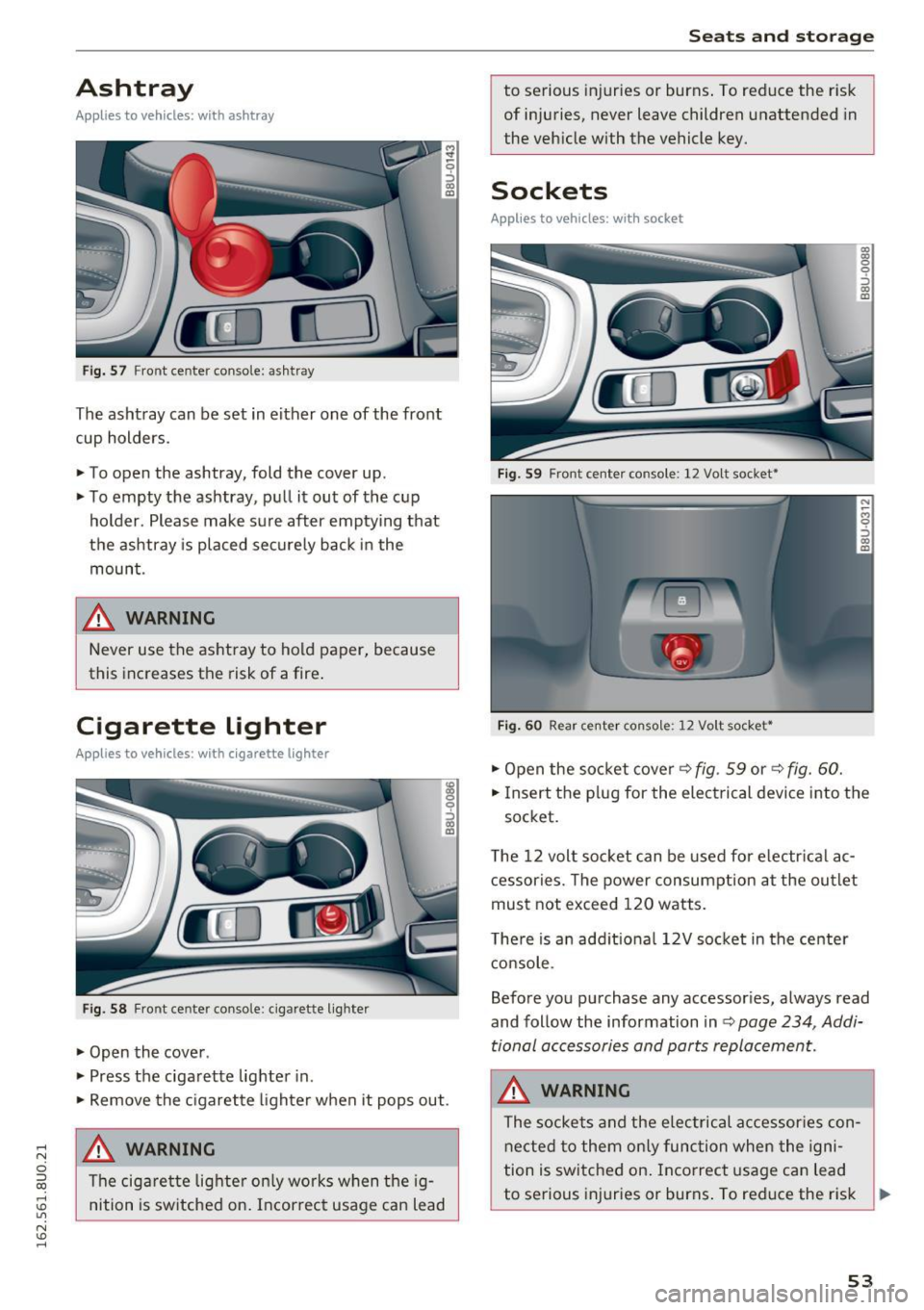
.... N
c:i ::J CX)
.... I.Cl U"I
N I.Cl ......
Ashtray
Applies to vehicles: with ashtray
Fig. 57 Front center console: as htray
The ashtray can be set in either one of the front
cup holders.
~ To open the ashtray, fold the cover up.
~ To empty the ashtray, pu ll it out of the c up
holder . Please make sure after emptying that
the ashtray is placed securely back in the
moun t.
& WARNING
Never use the as htray to hold paper, because
this increases the risk of a fire .
Cigarette lighter
Applies to vehicles: with cigarette lighter
Fig. 58 Fr ont ce nter console: ciga rette lig hter
~ Open the cove r.
~ Press the ciga rette lighter in.
~ 9 ::::,
"' a,
~ Remove the c igarette lighter when it pops out .
& WARNING
The cig arette lig hter o nly wor ks w hen the ig
nition is sw itched on. Incorrec t usage can lead
Seats and storag e
to serious injuries or burns . To reduce the r is k
of injuries, never leave children unattended in
the veh icle with the vehicle key.
Sockets
Applies to vehicles: with socket
F ig . 59 Fro nt cente r conso le: 12 Vo lt socket•
Fi g. 60 Rea r ce nte r conso le: 12 Vo lt socket•
~ O pen the so cket cover~ fig . 59 or~ fig. 6 0.
~ 0
::> (10 m
~ Insert the p lug for the elect rical devi ce i nto the
socket.
T he 12 volt soc ket can be used fo r electr ical ac
cessories. The power consump tion at the ou tlet
mus t not exceed 120 watts.
T he re is a n add it iona l 12V soc ket in the center
c onsole .
Before you pu rchase any accessor ies, always read
and follow the information in
Q page 234, Addi
tional accessories and parts replacemen t.
& WARNING
The socke ts an d the e lec trical a ccessor ies con
ne cte d to them on ly func tion when the igni
tion i s switched on . Incorrect usage can lead
to se rious inj uries or burns . To reduce the risk ..,.
53
Page 56 of 252
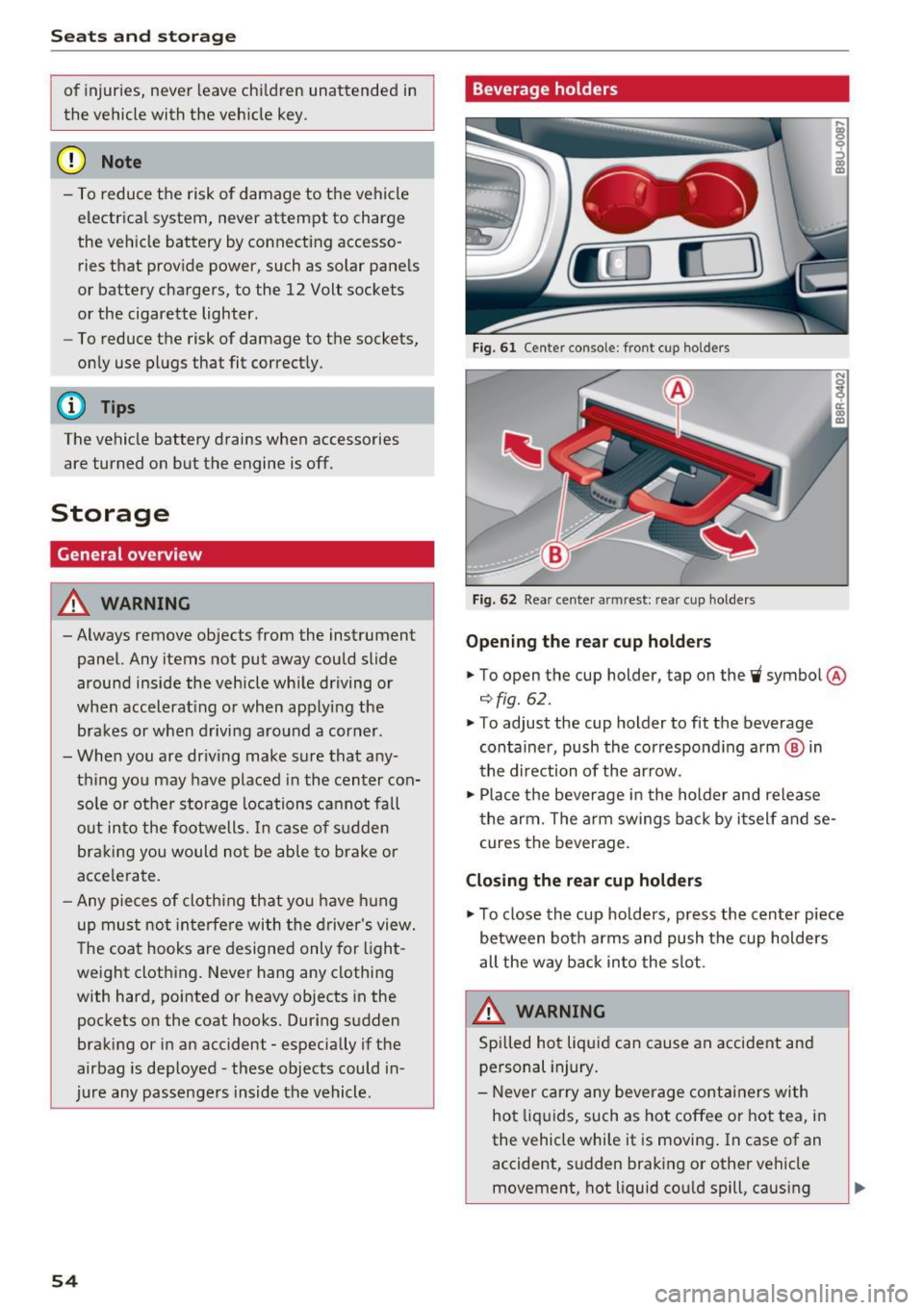
Sea ts and stor age
of injuries, never leave ch ildren unattended in
the vehicle with the veh icle key.
(D Note
- To reduce the risk of damage to the vehicle
electrica l system, never attempt to charge
the vehicle battery by connecting accesso
ries that prov ide power , such as solar panels
or battery chargers, to the 12 Volt sockets
or the cigarette lighter .
- To reduce the risk of damage to the sockets,
only use plugs that fit correct ly.
{!) Tips
The vehicle battery drains when accessories
are turned on but the engine is off.
Storage
General overview
A WARNING
- Always remove objects from the instrument panel. Any items not put away could slide
around inside the vehicle wh ile driving or
when accelerat ing or when applying the
brakes or when drivi ng a round a corner .
- When you are dr iving make sure that any
thing you may have placed in the center con
so le or othe r storage locations cannot fall
o ut into the footwells. In case of sudden
br ak in g you would not be able to brake or
acce lerate .
- Any pieces of cloth ing that you have hung
up mus t not in te rfe re with the driver 's view.
The coat hooks a re designed only fo r light
weight clothing. Never hang any clothing
with hard, pointed or heavy objects in the
pockets on the coat hooks. Dur ing sudden
braking or in an accident- especially if the
airbag is deployed -these objects could in
jure any passengers inside the vehicle .
54
Beverage holders
Fig. 61 Center consol e: fr ont cup holders
Fi g. 62 Rea r cen te r armrest : rea r cup ho lde rs
Opening the re a r cup ho lder s
.. To open the cup holder , tap on the~ symbol @
¢fig. 62.
.. To adjust the cup holder to fit the beverage
container, push the correspond ing arm ® in
the direction of the ar row .
.,. Place the beverage in the holder and release
t he arm. The a rm swings ba ck by i tself and se
cures the beverage .
Closing the rear cup holders
.,. To close the cup holders , press the center piece
between both arms and push the cup holders
all the way back into the slot.
A WARNING
Spilled ho t liqui d can cause a n accident and
personal injury .
- Never carry any beverage containers with
ho t liquids, such as hot coffee or hot tea, i n
the vehicle while it is moving . In case of an
accident, s udden braking or other vehicle
movement, hot liquid cou ld spill , causing
-
Page 57 of 252
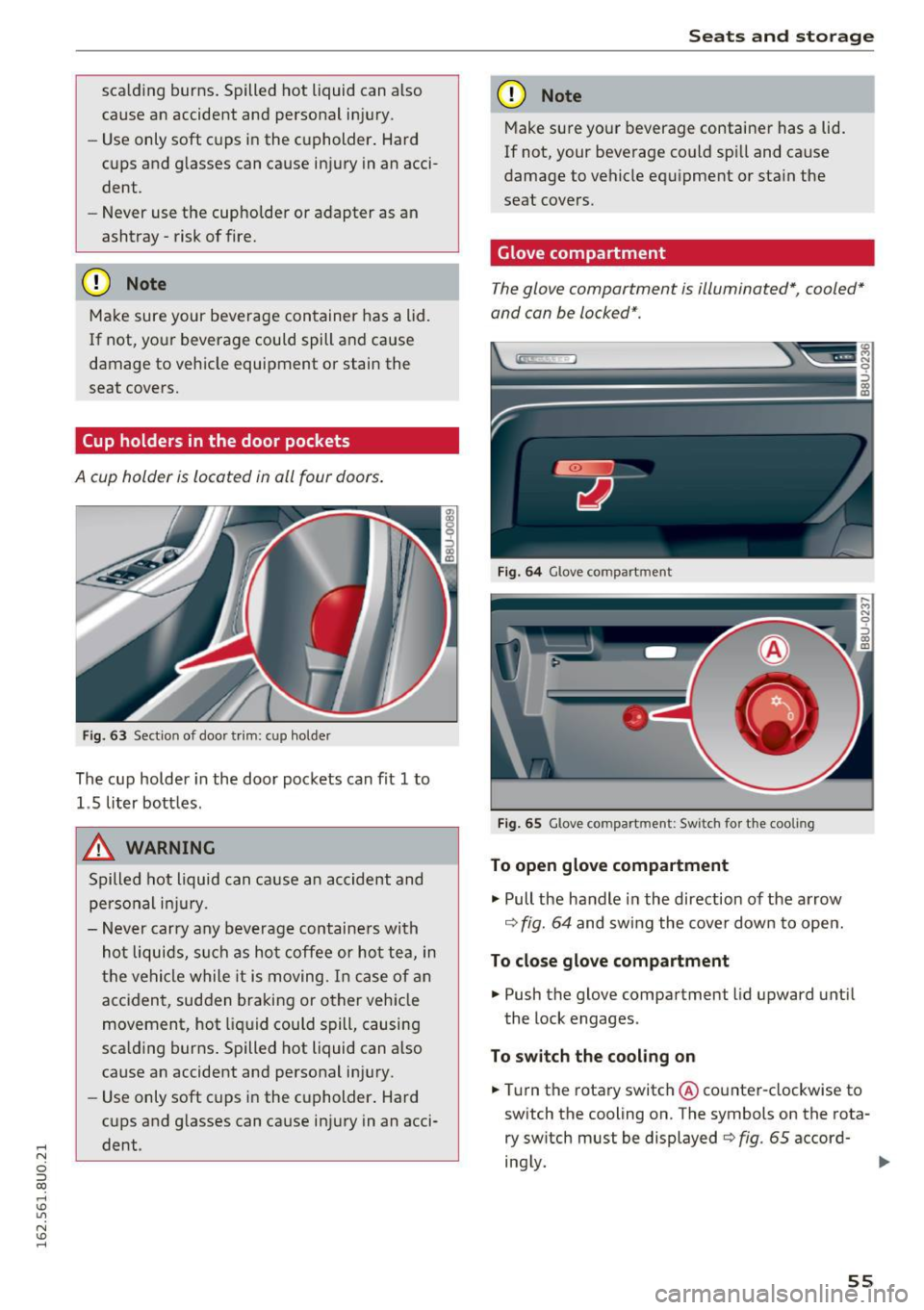
.... N
c:i ::J CX)
.... I.Cl U"I
N I.Cl ......
scald ing burns . Spilled hot liquid can also
cause an accident and personal injury .
- Use only soft c ups in the cupholder . Hard
c u ps and g lasses can cause injury in an acci
dent .
- Never use the cup holde r or adapter as an
ashtray -risk of fire.
CD Note
Ma ke sure your bever age container has a lid .
If not, yo ur beverage could spill a nd cause
damage to vehicle equipment or stain the
seat covers.
Cup holders in the door pockets
A cup hold er is located in all four doors.
F ig . 63 Sect io n of doo r trim : cup ho lde r
The cup holder in the door pockets can fit 1 to
1.5 liter bott les .
A WARNING
Spilled h ot l iquid can cause a n accident and
p ersonal i njury.
- Never carry any beverage con taine rs wi th
hot li quids, s uch as ho t coffee or ho t te a in
I
the ve hicle while it is moving. I n case of a n
acciden t, sud den braking or o ther vehi cle
movement, hot liq uid could s pill, causing
sca ld ing burns . Spilled hot liquid can also
cause an accident and perso nal in jury.
- Use only soft c ups in the c upholder . Hard
c u ps and g lasses can ca use inj ury in an acci
dent .
-
Seats and storag e
CD Note
Make su re your beverage contai ner has a lid.
If not, your beve rage co uld sp ill and cause
damage to vehicle eq uipment or sta in the
seat covers.
Glove compartment
T he glove compartment is illuminated*, cooled*
and can be locked* .
Fig. 64 Glove co mpart ment
Fig . 65 Glove co mpart ment: Sw itch for t he coo ling
To open glove compartment
"'Pull the handle in the direction of the arrow
¢ fig. 64 and swing the cover dow n to open.
To close glove compartment
"' Push the glove compartment lid upward unti l
the lock engages .
To switch the cooling on
"'Tu rn the rotary switch @ counter-clockwise to
sw itch the cooling on. The symbols on the rota
ry switch must be displayed c> fig . 65 accord-
ing ly.
Iii>
55
Page 58 of 252
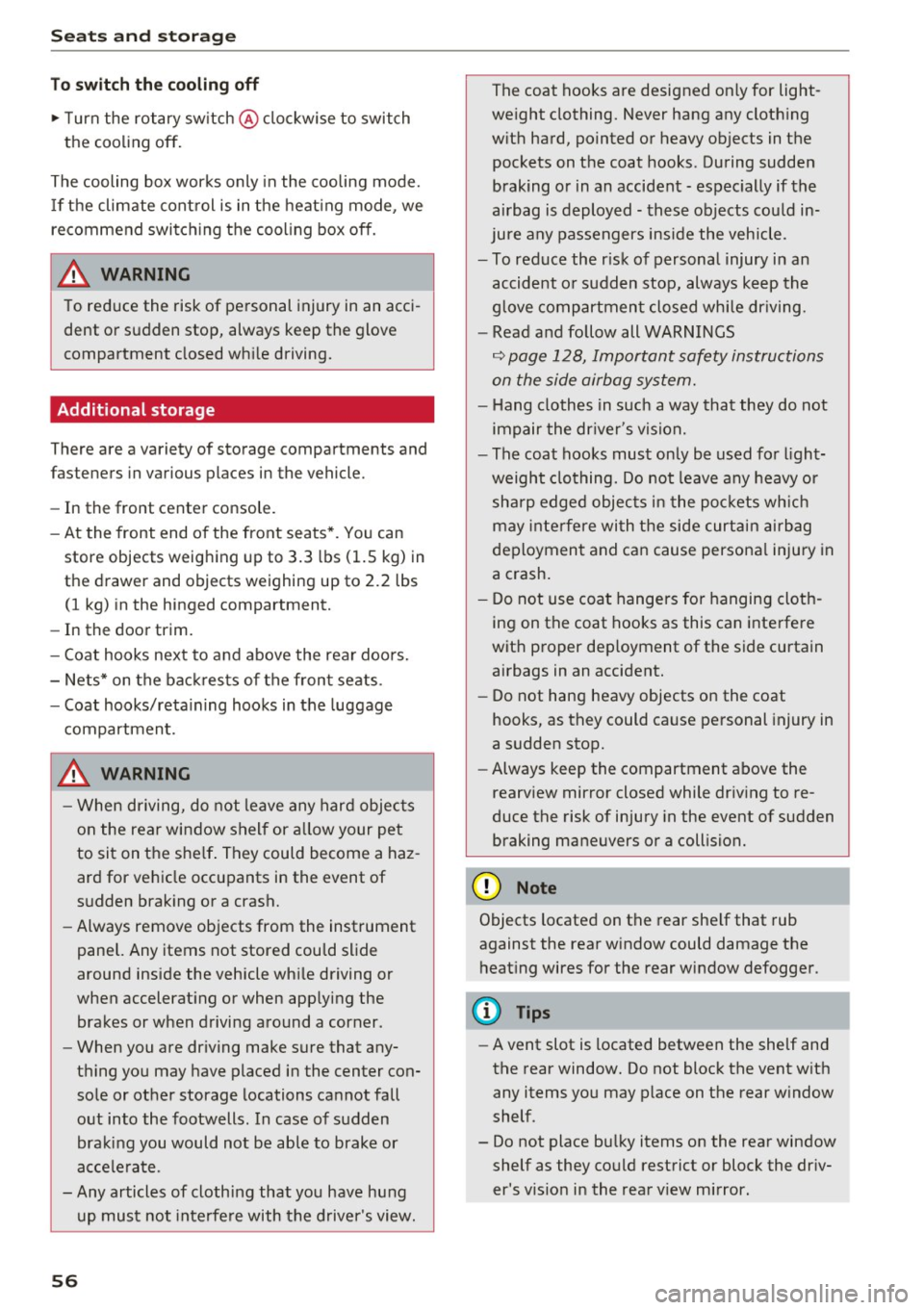
Seats and storage
To switch the cooling off
.,. Turn the rotary switch @clockwise to switch
the cooling off.
The cooling box works only in the cooling mode.
If the climate control is in the heating mode, we
recommend switching the cooling box off.
& WARNING
To reduce the risk of personal injury in an acci
dent or sudden stop, always keep the glove
compartment closed while driving.
Additional storage
There are a variety of storage compartments and
fasteners in various places in the vehicle.
- In the front center console.
- At the front end of the front seats*. You can
store objects weighing up to 3.3 lbs (1.5 kg) in
the drawer and objects weighing up to 2.2 lbs (1 kg) in the hinged compartment.
- In the door trim.
- Coat hooks next to and above the rear doors.
- Nets* on the backrests of the front seats.
- Coat hooks/retaining hooks in the luggage
compartment.
& WARNING
- When driving, do not leave any hard objects
on the rear window shelf or allow your pet
to sit on the shelf. They could become a haz
ard for vehicle occupants in the event of
sudden braking or a crash.
- Always remove objects from the instrument
panel. Any items not stored could slide
around inside the vehicle while driving or
when accelerating or when applying the
brakes or when driving around a corner.
- When you are driving make sure that any
thing you may have placed in the center con
sole or other storage locations cannot fall
out into the footwells. In case of sudden
braking you would not be able to brake or
accelerate.
- Any articles of clothing that you have hung
up must not interfere with the driver's view.
56
The coat hooks are designed only for light
weight clothing. Never hang any clothing
with hard, pointed or heavy objects in the pockets on the coat hooks. During sudden
braking or in an accident - especially if the
airbag is deployed - these objects could in
jure any passengers inside the vehicle.
- To reduce the risk of personal injury in an
accident or sudden stop, always keep the
glove compartment closed while driving.
- Read and follow all WARNINGS
~ page 128, Important safety instructions
on the side airbag system.
-Hang clothes in such a way that they do not
impair the driver's vision.
- The coat hooks must only be used for light
weight clothing. Do not leave any heavy or
sharp edged objects in the pockets which
may interfere with the side curtain airbag
deployment and can cause personal injury in
a crash.
- Do not use coat hangers for hanging cloth
ing on the coat hooks as this can interfere
with proper deployment of the side curtain airbags in an accident.
- Do not hang heavy objects on the coat
hooks, as they could cause personal injury in
a sudden stop.
- Always keep the compartment above the
rearview mirror closed while driving to re
duce the risk of injury in the event of sudden
braking maneuvers or a collision.
(D Note
Objects located on the rear shelf that rub
against the rear window could damage the heating wires for the rear window defogger.
(D Tips
-A vent slot is located between the shelf and
the rear window. Do not block the vent with
any items you may place on the rear window
shelf.
- Do not place bulky items on the rear window shelf as they could restrict or block the driv
er's vision in the rear view mirror.
Page 59 of 252
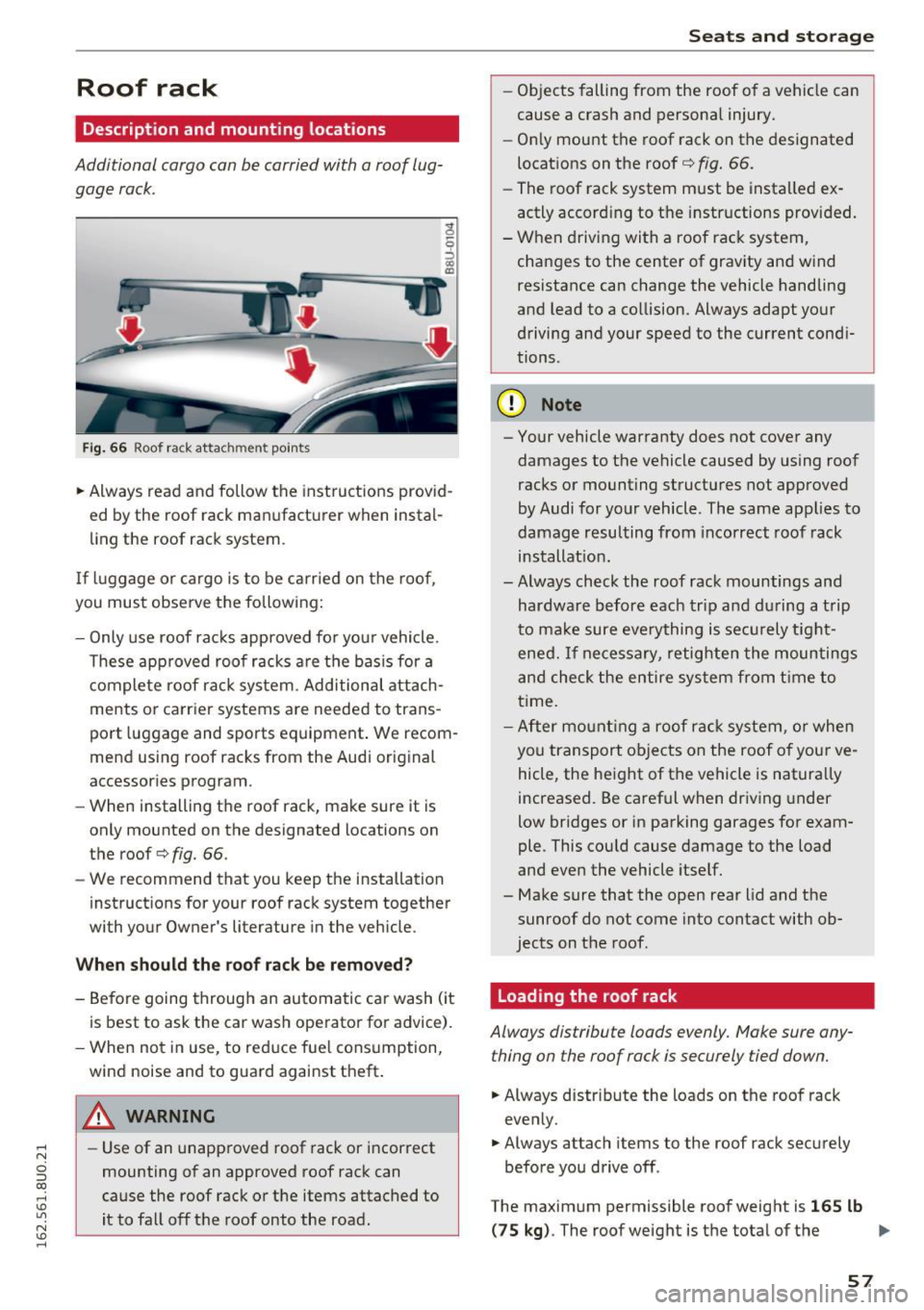
.... N
c:i ::J CX)
.... I.Cl U"I
N I.Cl ......
Roof rack
Description and mounting locations
Additional cargo can be carried with a roof lug
gage rack.
Fig. 6 6 Roof rack attach ment points
.. Always read and follow the inst ruct ions prov id
ed by the roof rack man ufacturer when instal
l ing the roof rack system .
If luggage or cargo is to be carried on the roof,
you must observe the following:
- Only use roof rac ks approved fo r you r vehicle.
T hese app roved roof racks a re the bas is for a
complete roof ra ck system . Additional attach
ments or carrier systems are needed to trans
port luggage and sports equipment . We recom
mend using roof racks from the Audi orig inal
accessor ies program .
- When installing the roof rack, make sure it is
only mounted on the designated locations on
the roof¢
fig. 66.
- We recommend that you keep the installat ion
instruct ions for your roof rack system together
with your Owner's literature in the veh icle.
When should th e roof rack b e re mov ed?
- Before going through an au tomatic car wash (it
is best to ask the car wash operator for advice).
- When not in use, to reduce fue l consumption,
wind noise and to guard against theft .
_& WARNING
-Use of an unapproved roof rack or i ncorrect
mounting of an approved roof rack can
cause the roof rack o r the items attached to
it to fall off the roof onto the road .
Seats and storage
-Objects falling from the roof of a vehicle can
cause a crash and personal injury.
- On ly mount the roof rack on the designated
locations on the roof¢
fig. 66.
- The roof rack system must be insta lled ex
actly accord ing to the instr uctions provided .
- W hen driving with a roof rac k system,
changes to the center of grav ity and w ind
resistance can change the vehicle handling
and lead to a co llision. Always adapt your
driving and your speed to the current cond i
tions.
(D Note
- Your vehicle warranty does not cover any
damages to the vehicle caused by using roof
racks or mount ing structu res not approved
by Audi for yo ur vehicle . The same app lies to
damage resulting from incorrect roof rack
installat ion.
- Always check the roof rack mountings and
hardwa re before each trip and during a t rip
to ma ke sure eve rything is se cu rely t ight
ened. If ne cess ary, retighte n the mountings
and check the entire sys tem from time to
t ime.
- After moun ting a roof ra ck system, or when
yo u transport objects on the roof o f you r ve
hicle, the he ight of the vehicle is natura lly
increased. Be caref ul when driving under
low bridges or in pa rking garages for exam
ple. This cou ld cause damage to the load
and eve n the vehicle itse lf.
- Make sure that the open rear lid and the sunroof do not come into contact with ob
jects on the roof.
Loading the roof rack
Always distribute loads evenly. Make sure any
thing on the roof rack is securely tied down.
.. Always distr ibute the loads on the roof rack
eve nly .
.. Always attach items to the roof rack secu rely
before you drive off .
The maxim um permissible roof weig ht is
165 lb
(75 kg) . The roof weight is the total of the Ill>
57
Page 60 of 252
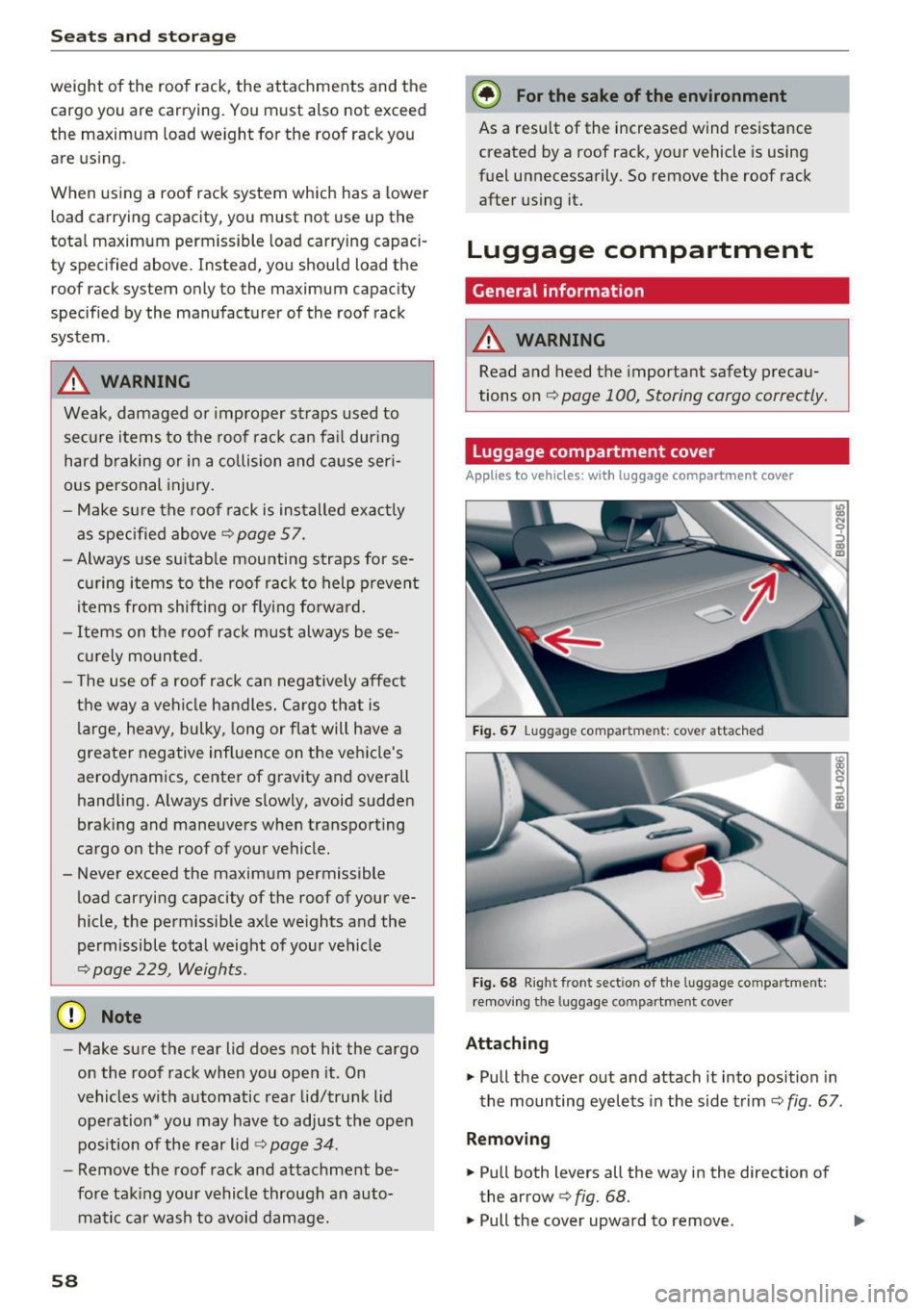
Sea ts and stor age
weight of the roof rack, the attachments and the
cargo you are carrying. You must also not exceed
the maximum load we ight for the roof rack you
are us ing.
When us ing a roof rack system which has a lower
load carrying capacity, you must not use up the
tota l maximum permissible load carrying capaci
ty spec ified above. Instead, you should load the
roof rack system only to the maximum capacity
specified by the manufacturer of the roof rack
system.
A WARNING
Weak, damaged o r improper st raps us ed to
sec ure i tems to the roof rack can fa il dur ing
h ard br aking or in a collision and ca use seri
ous person al injury.
- Make s ure the roof rack is installed exact ly
as specified above
¢page 57.
- Always use suitab le mounting s traps for se
c u ring i tems to the roof rack to help prevent
items from sh ifting or f ly ing fo rward.
- Items on t he roof ra ck m ust always be se
c ur ely moun ted.
- T he use of a roof rack can negatively affect
the way a vehicle h andles. Ca rgo that is
la rge, heavy, bulky, long or fla t will have a
greate r negative influence on the ve hicle's
aerodynamics, center of gravity and overall handling. Always drive slowly, avoid sudden
braking and maneuvers when transporting
cargo on the roof of your vehicle.
- Never exceed the maximum permissible
load carryi ng capacity of the roof of your
ve
hicle, the permissible axle we ights a nd the
permissible total weight of your vehicle
¢ page 229, Weights.
(D Note
- Make sure the rear lid does not hit the cargo
on the roof rack when you open it. On
vehicles with automatic rear lid/trunk lid
operation* you may have to adjust the open position of the rear lid ¢
page 34.
-Remove the roof rack and attachment be
fo re tak ing your vehicl e through an auto
mati c car wash to avo id damage.
58
-
@) For the sake of the environment
As a resu lt of the increased wind resistance
created by a roof rac k, yo ur vehicle is using
f u el unnecessa rily. So remove the roof rack
after using it.
Luggage compartment
General information
A WARNING
Read and heed the important safety precau
tions o n¢
page 100 , Storing cargo correctly.
Luggage compartment cover
App lies to vehicles: wit h lu ggage compartment cover
Fi g. 6 7 Luggage compartment: cover attached
Fig . 68 R ight front section of the l uggage compartment:
r emov ing the luggage compartment cover
Attaching
-
.,. Pull the cover out and attach it into position in
the mounting eyelets in the side trim¢
fig. 67.
Remo ving
.,. Pull both levers all the way in the direction of
the arrow ¢
fig. 68.
.,. Pull the cover upward to remove.